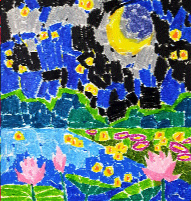for %%a in (%MyFiles%) do ffmpeg -i "%%a" -y -lavfi showspectrumpic=s=1920x1080:color=fiery:gain=.7:fscale=lin:orientation=0:saturation=1:mode=combined:legend=enabled:start=0:stop=8000 "%%~na.jpg"

http://www.rhci-online.net/radiogram/radiogram.htm
https://github.com/GyanD/codexffmpeg/releases/tag/2023-03-05-git-912ac82a3c
set MyFiles=*.flac *.fla *.wav *.aif *.mp4 *.mp3 *.mp2 *.aac *.ogg
*.m4a

RSID: <<2023-04-20T23:31Z
MFSK-32 @
9265000+1500>>
Welcome to program 301 of Shortwave Radiogram.
I'm Kim Andrew Elliott in Arlington, Virginia USA.
Here is the lineup for today's program, in MFSK modes as noted:
1:37 MFSK32: Program preview (now)
2:45 MFSK32: Saturn's icy rings probably heat its atmosphere*
9:15 MFSK64: Citizen scientists can hear the "sounds" of space
14:04 MFSK64: This week's images*
28:43 MFSK32: Closing announcements
* with image(s)
Please send reception reports to
radiogram@verizon.net
And visit http://swradiogram.net
We're on Twitter now: @SWRadiogram
From Science News:
Saturn's icy rings are probably heating its atmosphere, giving it
an ultraviolet glow
Water ice falling into the planet's upper atmosphere may
create an excess UV emission
By Ken Croswell
April 17, 2023
The rings that make Saturn such a spectacle are probably heating
its atmosphere and making it glow at ultraviolet wavelengths.
Researchers detected an excess of ultraviolet emission in
Saturn's northern hemisphere that comes from hydrogen atoms. The
emission, known as Lyman-alpha radiation, is probably the result
of water ice, which contains hydrogen, falling into the
atmosphere from the planet's rings, the researchers propose March
30 in the Planetary Science Journal.
The detection of similar emission from a distant world could
someday lead to the discovery of a Saturn-like planet orbiting
another star.
The key to the discovery came after two spacecraft - the Hubble
Space Telescope and Cassini - observed Saturn simultaneously in
2017, right before Cassini plunged into the planet's atmosphere,
says Lotfi Ben-Jaffel, an astrophysicist at the Institut
d'Astrophysique de Paris.
This allowed Ben-Jaffel and colleagues to calibrate the
ultraviolet detectors on those spacecraft as well as detectors on
Voyager 1 and 2, which flew past Saturn in 1980 and 1981, and the
International Ultraviolet Explorer, an Earth-orbiting satellite
that also observed Saturn. Comparing these ultraviolet
observations revealed a band of excess Lyman-alpha radiation
spanning 5° to 35° N latitude on Saturn.
The researchers' explanation for the extra ultraviolet glow is
plausible, says Paul Estrada, a planetary scientist at NASA's
Ames Research Center in Moffett Field, Calif., who was not
involved with the new work.
"We know material is falling in from the rings," he says, because
Cassini detected it during the spacecraft's spiral into Saturn.
"The rings are predominantly water ice. It may be the source of
the atomic hydrogen" emitting the Lyman-alpha radiation that the
researchers have detected, he says.
When icy ring particles fall into Saturn's atmosphere, they carry
kinetic energy with them. "They have to release that energy to
the surrounding gas," Ben-Jaffel says, and that energy heats up
the atmosphere. When the icy particles vaporize, they release
additional energy, further heating the atmosphere and making it
glow at UV wavelengths. The researchers suspect that the emission
also appears in the planet's southern hemisphere.
All the giant planets of our solar system have rings, but only
Saturn's are so bright and beautiful. Astronomers don't yet know
whether any of the thousands of worlds found orbiting other stars
have rings that are equally magnificent.
The new discovery may help astronomers identify those
spectacularly ringed worlds, if they exist. Future planet hunters
could look for the telltale ultraviolet glow of the Lyman-alpha
radiation, Ben-Jaffel says, and then further observations could
confirm the rings' existence.
https://www.sciencenews.org/article/saturn-icy-ring-heat-atmosphere-ultraviolet-glow
Image: Glowing hydrogen atoms form the white band in Saturn's
northern hemisphere, seen here in this composite, ultraviolet
Hubble Space Telescope image.
Sending Pic:153x149C;

Shortwave Radiogram now changes to MFSK64 ...
RSID: <<2023-04-20T23:40Z
MFSK-64
@
9265000+1500>>
This is Shortwave Radiogram in MFSK64
Please send your reception report to radiogram@verizon.net
From Phys.org:
Help discover the sounds of space played by NASA's HARP
by Vanessa Thomas
NASA's Goddard Space Flight Center
April 19, 2023
In 2007, NASA launched five satellites as part of the Time
History of Events and Macroscale Interactions during Substorms,
or THEMIS, mission. Spread out across the magnetosphere, the
THEMIS spacecraft studied how plasma and energy moving through
Earth's environment trigger different types of auroras (northern
and southern lights). In 2010, two spacecraft were reassigned to
study the Moon's environment, but the other three continue to
investigate Earth's magnetosphere and auroras. Credit:
NASA/Goddard Space Flight Center Conceptual Image Lab
Earth's magnetic environment is filled with a symphony of sound
that we cannot hear. All around our planet, ultralow-frequency
waves compose a cacophonous operetta portraying the dramatic
relationship between Earth and the sun.
Now, a new citizen science project called HARP - or Heliophysics
Audified: Resonances in Plasmas - has turned those once-unheard
waves into audible whistles, crunches, and whooshes. Early tests
have already made surprising finds, and citizen scientists can
join the journey of sonic space exploration to decipher the
cosmic vibrations that help sing the song of the sun and Earth.
"What excites me most about the HARP project is the ability for
citizen scientists to make new discoveries in heliophysics
research through audio analysis," said the project's principal
investigator, Michael Hartinger, a heliophysicist at the Space
Science Institute in Colorado. "We need their help to understand
complex patterns in the near-Earth space environment."
Between Earth and the sun, space is not truly empty but is filled
with a soup of charged particles called plasma. This plasma comes
from the sun, pumped out in a steady stream called the solar wind
and sporadically blasted away in explosive solar eruptions. When
this solar plasma strikes Earth, it causes the magnetic field
lines and plasma around Earth to vibrate like the plucked strings
of a harp, producing ultralow-frequency waves.
In 2007, NASA launched five satellites to fly through Earth's
magnetic "harp" - its magnetosphere - as part of the THEMIS mission
(Time History of Events and Macroscale Interactions during
Substorms). Since then, THEMIS has been gathering a bounty of
information about plasma waves across Earth's magnetosphere.
"THEMIS can sample the whole harp," Hartinger said, "and it's
been out there a long time, so it has collected a lot of data."
The frequencies of the waves THEMIS measures are too low for our
ears to hear, however. So the HARP team sped them up to convert
them to sound waves. By using an interactive tool developed by
the team, you can listen to these waves and pick out interesting
features you hear in the sounds.
"The process of identifying new features through deep listening
feels a bit like treasure hunting," said Robert Alexander, a HARP
team member from Auralab Technologies in Michigan. "I'm excited
for individuals around the world to get a taste of this
experience through the HARP project."
According to the team, humans are often better at picking out
interesting wave patterns by ear than by eye - and can even do
better than computers at identifying complex patterns that emerge
during extreme solar events.
"The human sense of hearing is an amazing tool," said HARP team
member Martin Archer of Imperial College London. "We're
essentially trained from birth to recognize patterns and pick out
different sound sources. We can innately do some pretty crazy
analysis that outperforms even some of our most advanced computer
algorithms."
HARP was inspired by an earlier sonification project led by
Archer called MUSICS (Magnetospheric Undulations Sonified
Incorporating Citizen Scientists). When Archer asked high school
students in London to listen to sonified data (measurements
converted into sound) from National Oceanic and Atmospheric
Association (NOAA) satellites, they identified a new plasma wave
pattern related to solar storms.
"London high school students were able to pick out a complex but
repeatable pattern in the sound that the automated methods
missed," Hartinger said. "HARP is going to take this to a new
level working with a much larger dataset from NASA's THEMIS
mission and with a much larger online audience."
There's an advantage to having a wide and diverse group of people
listen to the sounds, the team says.
"Everyone hears the world differently," explained Emmanuel
Masongsong of the University of California, Los Angeles, who is a
HARP team member and a member of NASA's THEMIS mission. "Every
participant will react uniquely to the vibrations in space. What
one person ignores, another may be drawn to immediately. We want
people to discover things that we never considered, or that
computer algorithms would not be able to detect. That's how
discoveries are made!"
Preliminary investigations with HARP have already started
revealing unexpected features, such as what the team calls a
"reverse harp" - frequencies changing in the opposite way than
what scientists anticipated.
"HARP has the potential to find things that we weren't expecting,
which is really exciting," Archer stated.
HARP could also provide insights about phenomena that other NASA
citizen scientists have encountered, such as sounds heard by
amateur radio operators participating in the HamSCI project, or
wave-like auroras examined through the Aurorasaurus project.
"Data sonification provides human beings with an opportunity to
appreciate the naturally occurring music of the cosmos," said
Alexander. "We're hearing sounds that are literally out of this
world, and for me that's the next best thing to floating in a
spacesuit."
To start exploring these sounds, visit the HARP website:
https://listen.spacescience.org/
https://phys.org/news/2023-04-space-played-nasa-harp.html
This is Shortwave Radiogram in MFSK64
Please send your reception report to radiogram@verizon.net
This spiral among the Northern Lights was caused by excess fuel
released from a SpaceX rocket that launched from California,
April 15.
https://t.ly/Pr4p ...
Sending Pic:153x198C;

Mocca, a pet rabbit, among dandelions in Ankara, April 11.
https://t.ly/FZos ...
Sending Pic:189x160C;

Sunrise over the Anacostia River in Washington DC, April 16 ...
Sending Pic:148x203C;

Wildflowers at Myrtle Beach State Park, South Carolina.
https://t.ly/chit
Sending Pic:214x110C;

A just-opening Desert Death Camas (Toxicoscordion
brevibracteatum) in Red Rock Canyon State Park, California.
https://t.ly/U-7M ...
Sending Pic:190x164C;

Spring Beauty (Claytonia virginica) bloom from April through June
in shady, moist woods across much of the eastern half of the U.S.
and Canada.
https://t.ly/XzTg ...
Sending Pic:202x140C

A red-billed leiothrix in India.
https://t.ly/e_Nm ...
Sending Pic:199x169C;

Our painting of the week is "Fireflies" by Rahul Kashyap.
https://bit.ly/3MYURaI ...
Sending Pic:191x201C;

Shortwave Radiogram returns to MFSK32 ...
RSID: <<2023-04-13T23:59Z MFSK-32 @ 9265000+1500>>
This is Shortwave Radiogram in MFSK32 ...
Shortwave Radiogram is transmitted
by:
WRMI, Radio Miami International, wrmi.net
and
WINB Shortwave, winb.com
Please send reception reports to
radiogram@verizon.net
And visit http://swradiogram.net
Twitter:
@SWRadiogram or
twitter.com/swradiogram
I'm Kim Elliott. Please join us for the next Shortwave
Radiogram.
|
SWRG#301 closing song:
https://en.wikipedia.org/wiki/Ahmad_Jamal Ahmad Jamal - Poinciana - LIVE HD
|
http://www.rhci-online.net/radiogram/radiogram.htm
|
QTH: |
D-06193 Petersberg (Germany/Germania) |
|
|
Ant.: |
Dipol for 40m-Band & Boomerang Antenna 11m-Band |
|
|
RX for RF: |
FRG-100B + IF-mixer & ICOM IC-R75 + IF-mixer |
|
|
Software IF: |
con STUDIO1 - Software italiano per SDR on Windows 11 [S-AM-USB/LSB] + HDSDR 2.81 beta6 - for scheduled IF-recording |
|
|
Software AF: |
Fldigi-4.1.26 + flmsg-4.0.20 images-fldigifiles on homedrive.lnk |
|
|
OS: |
Mirosoft Windows 11 Home |
German W7 32bit + 64bit |
|
PC: |
ASUS S501MD (since 2023) [i7-12700 12th Gen. 12 x 2100 MHz] |
MSI-CR70-2MP345W7 (since 2014) [i5 -P3560 ( 2 x 2600 MHz) ] |
http://wiki.radioreference.com/index.php/Decoding_the_SW_Radiogram_Broadcasts
https://www.qsl.net/ve7vv/Files/Digital%20Modes.pdf
RSID: <<2023-04-23T22:30Z MFSK-64 @ 5950000+1500>>
Roy Orbison was born on
April 23, 1936.
He died in 1988.
Sending Pic:180x250;

https://royorbison.com/
Please report your decode
to themightykbc@gmail.com.